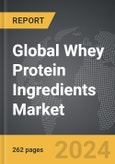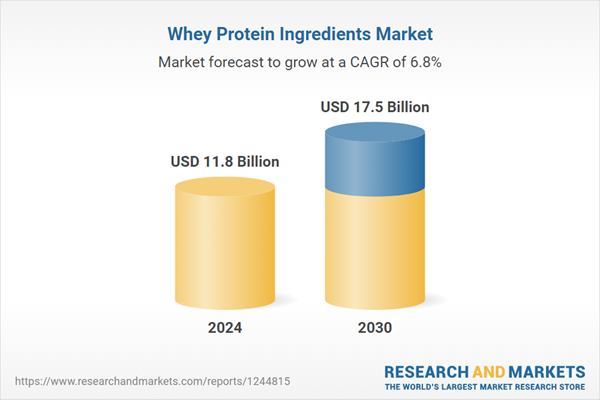The global market for Whey Protein Ingredients was valued at US$11.8 Billion in 2024 and is projected to reach US$17.5 Billion by 2030, growing at a CAGR of 6.8% from 2024 to 2030. This comprehensive report provides an in-depth analysis of market trends, drivers, and forecasts, helping you make informed business decisions. The report includes the most recent global tariff developments and how they impact the Whey Protein Ingredients market.
The application of whey protein ingredients extends far beyond the realm of sports nutrition into a myriad of food and beverage products. Food manufacturers are increasingly incorporating whey protein into a variety of products such as snacks, beverages, infant formulas, and functional foods to boost their nutritional content. The burgeoning trend towards high-protein diets has spurred the development of whey protein-fortified products, including protein bars, shakes, yogurts, and even baked goods. Innovations in food processing and technology have significantly enhanced the solubility, taste, and texture of whey protein, broadening its appeal and versatility. As a result, whey protein can now be found in clear protein drinks, smoothies, and even savory foods. Moreover, the growing awareness of the numerous health benefits associated with protein consumption - such as muscle maintenance, weight loss, immune support, and satiety - has driven demand across various consumer demographics. This expanding application spectrum illustrates the adaptability and growing importance of whey protein ingredients in modern food science and nutrition.
The growth in the whey protein ingredients market is driven by several factors. A key driver is the increasing consumer interest in health and wellness, with a particular emphasis on protein-rich diets. This is evident in the rise of the fitness and sports nutrition industry, where whey protein is a staple for muscle recovery and performance enhancement. Technological advancements in protein extraction and processing have resulted in the production of high-quality whey protein ingredients that cater to diverse consumer preferences, such as lactose-free options and enhanced flavor profiles. Additionally, the aging global population, which seeks to maintain muscle mass and overall health, is significantly contributing to market demand. The trend towards clean label products and transparency in ingredient sourcing is also propelling manufacturers to adopt whey protein, prized for its natural and minimally processed characteristics. Furthermore, the increasing popularity of functional foods and beverages that offer added health benefits is creating new opportunities for whey protein integration. This demand is bolstered by innovations in product development, such as protein-enriched ice creams and meal replacements, which appeal to health-conscious consumers seeking convenience without compromising on nutrition. These factors collectively underscore the dynamic nature of the whey protein ingredients market and its potential for sustained growth in the years ahead.
Segments: Type (Whey Protein Concentrates, Whey Protein Hydrolysates, Whey Protein Isolates); Application (Food & Beverages, Nutritional Supplements, Personal Care, Animal Feed & Pet Food).
Geographic Regions/Countries: World; United States; Canada; Japan; China; Europe (France; Germany; Italy; United Kingdom; Spain; Russia; and Rest of Europe); Asia-Pacific (Australia; India; South Korea; and Rest of Asia-Pacific); Latin America (Argentina; Brazil; Mexico; and Rest of Latin America); Middle East (Iran; Israel; Saudi Arabia; United Arab Emirates; and Rest of Middle East); and Africa.
The analysts continuously track trade developments worldwide, drawing insights from leading global economists and over 200 industry and policy institutions, including think tanks, trade organizations, and national economic advisory bodies. This intelligence is integrated into forecasting models to provide timely, data-driven analysis of emerging risks and opportunities.
Whey Protein Ingredients - Key Trends and Drivers
Whey protein ingredients, derived from the liquid byproduct of cheese production, have emerged as a cornerstone in the dietary and nutritional supplement industry. Whey protein is renowned for its complete amino acid profile, rapid digestibility, and high biological value, making it a go-to choice for muscle recovery, weight management, and overall health enhancement. The primary forms of whey protein ingredients are whey protein concentrate (WPC), whey protein isolate (WPI), and hydrolyzed whey protein. WPC typically contains around 70-80% protein, along with lactose, fat, and minerals, which makes it useful for those seeking the benefits of whey protein without the higher cost associated with purer forms. WPI, on the other hand, offers a protein concentration of 90% or higher, with minimal fat and lactose, catering to those with lactose intolerance or those requiring a higher protein intake. Hydrolyzed whey protein undergoes additional processing to break down protein molecules into smaller peptides, facilitating faster absorption and making it suitable for post-exercise recovery. These varied forms address a wide spectrum of consumer needs, from fitness enthusiasts and bodybuilders to individuals seeking convenient and high-quality protein sources in their diets.The application of whey protein ingredients extends far beyond the realm of sports nutrition into a myriad of food and beverage products. Food manufacturers are increasingly incorporating whey protein into a variety of products such as snacks, beverages, infant formulas, and functional foods to boost their nutritional content. The burgeoning trend towards high-protein diets has spurred the development of whey protein-fortified products, including protein bars, shakes, yogurts, and even baked goods. Innovations in food processing and technology have significantly enhanced the solubility, taste, and texture of whey protein, broadening its appeal and versatility. As a result, whey protein can now be found in clear protein drinks, smoothies, and even savory foods. Moreover, the growing awareness of the numerous health benefits associated with protein consumption - such as muscle maintenance, weight loss, immune support, and satiety - has driven demand across various consumer demographics. This expanding application spectrum illustrates the adaptability and growing importance of whey protein ingredients in modern food science and nutrition.
The growth in the whey protein ingredients market is driven by several factors. A key driver is the increasing consumer interest in health and wellness, with a particular emphasis on protein-rich diets. This is evident in the rise of the fitness and sports nutrition industry, where whey protein is a staple for muscle recovery and performance enhancement. Technological advancements in protein extraction and processing have resulted in the production of high-quality whey protein ingredients that cater to diverse consumer preferences, such as lactose-free options and enhanced flavor profiles. Additionally, the aging global population, which seeks to maintain muscle mass and overall health, is significantly contributing to market demand. The trend towards clean label products and transparency in ingredient sourcing is also propelling manufacturers to adopt whey protein, prized for its natural and minimally processed characteristics. Furthermore, the increasing popularity of functional foods and beverages that offer added health benefits is creating new opportunities for whey protein integration. This demand is bolstered by innovations in product development, such as protein-enriched ice creams and meal replacements, which appeal to health-conscious consumers seeking convenience without compromising on nutrition. These factors collectively underscore the dynamic nature of the whey protein ingredients market and its potential for sustained growth in the years ahead.
Report Scope
The report analyzes the Whey Protein Ingredients market, presented in terms of units. The analysis covers the key segments and geographic regions outlined below.Segments: Type (Whey Protein Concentrates, Whey Protein Hydrolysates, Whey Protein Isolates); Application (Food & Beverages, Nutritional Supplements, Personal Care, Animal Feed & Pet Food).
Geographic Regions/Countries: World; United States; Canada; Japan; China; Europe (France; Germany; Italy; United Kingdom; Spain; Russia; and Rest of Europe); Asia-Pacific (Australia; India; South Korea; and Rest of Asia-Pacific); Latin America (Argentina; Brazil; Mexico; and Rest of Latin America); Middle East (Iran; Israel; Saudi Arabia; United Arab Emirates; and Rest of Middle East); and Africa.
Key Insights:
- Market Growth: Understand the significant growth trajectory of the Whey Protein Concentrates segment, which is expected to reach US$8.6 Billion by 2030 with a CAGR of a 6.4%. The Whey Protein Hydrolysates segment is also set to grow at 6.8% CAGR over the analysis period.
- Regional Analysis: Gain insights into the U.S. market, valued at $3.1 Billion in 2024, and China, forecasted to grow at an impressive 10.9% CAGR to reach $4.0 Billion by 2030. Discover growth trends in other key regions, including Japan, Canada, Germany, and the Asia-Pacific.
Why You Should Buy This Report:
- Detailed Market Analysis: Access a thorough analysis of the Global Whey Protein Ingredients Market, covering all major geographic regions and market segments.
- Competitive Insights: Get an overview of the competitive landscape, including the market presence of major players across different geographies.
- Future Trends and Drivers: Understand the key trends and drivers shaping the future of the Global Whey Protein Ingredients Market.
- Actionable Insights: Benefit from actionable insights that can help you identify new revenue opportunities and make strategic business decisions.
Key Questions Answered:
- How is the Global Whey Protein Ingredients Market expected to evolve by 2030?
- What are the main drivers and restraints affecting the market?
- Which market segments will grow the most over the forecast period?
- How will market shares for different regions and segments change by 2030?
- Who are the leading players in the market, and what are their prospects?
Report Features:
- Comprehensive Market Data: Independent analysis of annual sales and market forecasts in US$ Million from 2024 to 2030.
- In-Depth Regional Analysis: Detailed insights into key markets, including the U.S., China, Japan, Canada, Europe, Asia-Pacific, Latin America, Middle East, and Africa.
- Company Profiles: Coverage of players such as Arla Foods Ingredients Group P/S, Carbery Food Ingredients, Cargill Inc., Dairy Farmers of America Inc., Davisco Foods International Inc. and more.
- Complimentary Updates: Receive free report updates for one year to keep you informed of the latest market developments.
Some of the 19 companies featured in this Whey Protein Ingredients market report include:
- Arla Foods Ingredients Group P/S
- Carbery Food Ingredients
- Cargill Inc.
- Dairy Farmers of America Inc.
- Davisco Foods International Inc.
- Foremost Farms USA
- Glanbia Plc
- Grande Custom Ingredients Group
- Hilmar Cheese Company
- MG Nutritionals
- Royal FrieslandCampina
- Valio Ltd.
- Volac International Ltd.
Tariff Impact Analysis: Key Insights for 2025
Global tariff negotiations across 180+ countries are reshaping supply chains, costs, and competitiveness. This report reflects the latest developments as of April 2025 and incorporates forward-looking insights into the market outlook.The analysts continuously track trade developments worldwide, drawing insights from leading global economists and over 200 industry and policy institutions, including think tanks, trade organizations, and national economic advisory bodies. This intelligence is integrated into forecasting models to provide timely, data-driven analysis of emerging risks and opportunities.
What’s Included in This Edition:
- Tariff-adjusted market forecasts by region and segment
- Analysis of cost and supply chain implications by sourcing and trade exposure
- Strategic insights into geographic shifts
Buyers receive a free July 2025 update with:
- Finalized tariff impacts and new trade agreement effects
- Updated projections reflecting global sourcing and cost shifts
- Expanded country-specific coverage across the industry
Table of Contents
I. METHODOLOGYII. EXECUTIVE SUMMARY2. FOCUS ON SELECT PLAYERSIII. MARKET ANALYSISCANADAITALYSPAINRUSSIAREST OF EUROPESOUTH KOREAREST OF ASIA-PACIFICARGENTINABRAZILMEXICOREST OF LATIN AMERICAIRANISRAELSAUDI ARABIAUNITED ARAB EMIRATESREST OF MIDDLE EASTIV. COMPETITION
1. MARKET OVERVIEW
3. MARKET TRENDS & DRIVERS
4. GLOBAL MARKET PERSPECTIVE
UNITED STATES
JAPAN
CHINA
EUROPE
FRANCE
GERMANY
UNITED KINGDOM
ASIA-PACIFIC
AUSTRALIA
INDIA
LATIN AMERICA
MIDDLE EAST
AFRICA
Companies Mentioned (Partial List)
A selection of companies mentioned in this report includes, but is not limited to:
- Arla Foods Ingredients Group P/S
- Carbery Food Ingredients
- Cargill Inc.
- Dairy Farmers of America Inc.
- Davisco Foods International Inc.
- Foremost Farms USA
- Glanbia Plc
- Grande Custom Ingredients Group
- Hilmar Cheese Company
- MG Nutritionals
- Royal FrieslandCampina
- Valio Ltd.
- Volac International Ltd.
Table Information
| Report Attribute | Details |
|---|---|
| No. of Pages | 262 |
| Published | April 2025 |
| Forecast Period | 2024 - 2030 |
| Estimated Market Value ( USD | $ 11.8 Billion |
| Forecasted Market Value ( USD | $ 17.5 Billion |
| Compound Annual Growth Rate | 6.8% |
| Regions Covered | Global |









